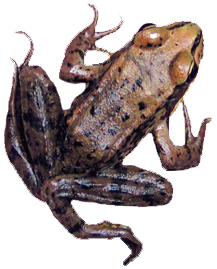Last Saturday, March 26, 2016, Maggie Rudy and I patrolled Marina Way, just above the wetland in which our local red-legged frogs breed. We’ve been thinking the migration was over, but there were good frog conditions that night: 52 degrees with light rain turning to mist and back again to rain. Once again Maggie proved herself the consummate frog catcher, and in the process caught the thousandth frog headed back to the forest from the wetland. When Maggie saw this photo taken with frog “M,” which I thought charming and amusing, her comment was, “Ha ha ... it looks like I’m about to pop it into my cauldron!” So there you have it; I wondered how it was that Maggie caught 19 frogs and I caught 1, and even that frog Maggie, out of pity, pointed out to me. All evening Maggie suddenly materialized next to me and caught invisible frogs. I think you can see what’s going on here.
In the last post I mentioned the imbalance in numbers this year: 688 frogs assisted downhill and 1016 going up, almost all the over 300 frog difference being males. (This compares to 580 down and 572 up for the 2013/14 season and 695 down and 750 up for the 2014/15 season, the number of males and females nearly balanced.) The mystery of this odd change has been solved! There have long been reports of frogs falling from the sky, this odd phenomenon attributed to cyclonic winds -- little tornados -- lifting frogs out of their wetland home and dropping them some distance away on a quaint village. Careful study by our scientific team has turned up an amazing insight into the lives of male Northern red-legged frogs that both explains raining frogs and how all these male frogs got to the wetland without our seeing and catching them! They can fly! Yes, amazing as it may seem, just below the dorsolateral fold, on either side of the male frog’s back, is a flap of loose skin the frog holds with it’s hands and feet, and quite like a flying squirrel, the frog can glide for quite some distance, like tiny caped crusaders. Rocket J. Squirrel, meet Jed I. Frog! According to these new observations by Dr. Norm Landia, of the Department of Fish and Wildlife, late at night the male frogs climb trees in the forest and glide all the way down to the wetland, avoiding our “assistance,” and demonstrating this astonishing evolutionary development.
A squadron of male red-legged frogs gathering in preparation for take off.


